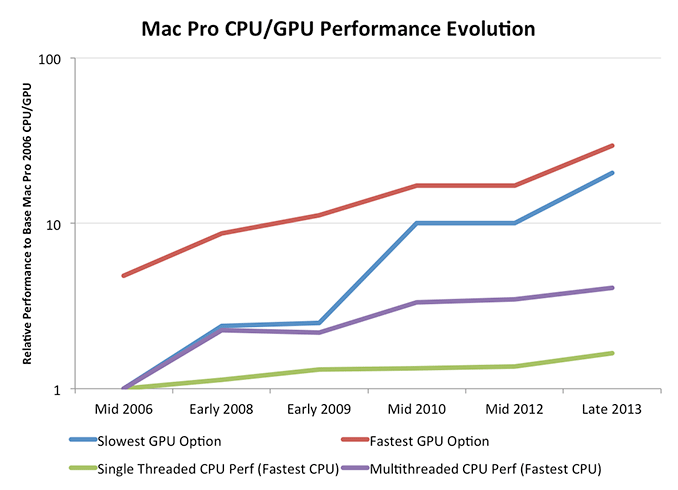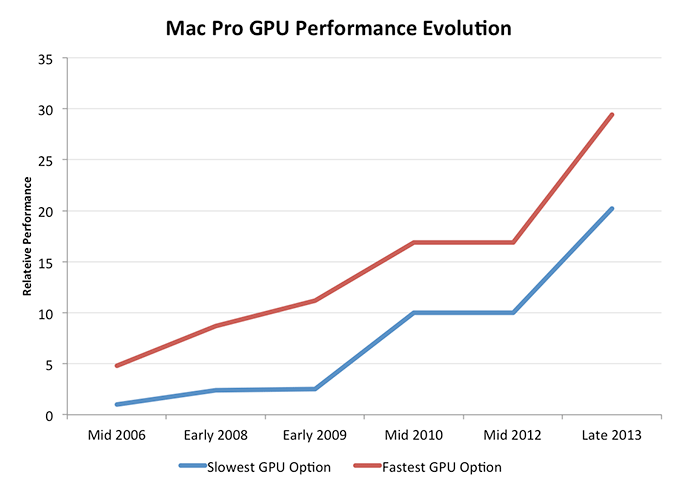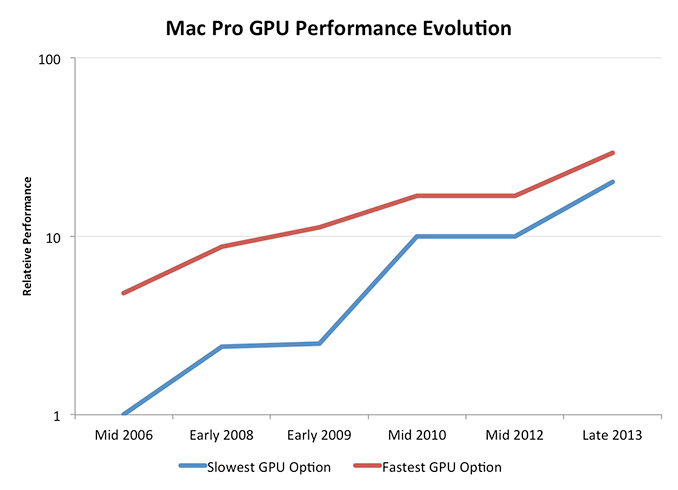The Mac Pro Review (Late 2013)
by Anand Lal Shimpi on December 31, 2013 3:18 PM ESTPlotting the Mac Pro’s GPU Performance Over Time
The Mac Pro’s CPU options have ballooned at times during its 7 year history. What started with four CPU options grew to six for the early 2009 - mid 2010 models. It was also during that time period that we saw an expansion of the number of total core counts from 4 up to the current mix of 4, 6, 8 and 12 core configurations.
What’s particularly unique about this year’s Mac Pro is that all configurations are accomplished with a single socket. Moore’s Law and the process cadence it characterizes leave us in a place where Intel can effectively ship a single die with 12 big x86 cores. It wasn’t that long ago where you’d need multiple sockets to achieve the same thing.
While the CPU moved to a single socket configuration this year, the Mac Pro’s GPU went the opposite direction. For the first time in Mac Pro history, the new system ships with two GPUs in all configurations. I turned to Ryan Smith, our Senior GPU Editor, for his help in roughly characterizing Mac Pro GPU options over the years.
| Mac Pro - GPU Upgrade Path | ||||||||||
| Mid 2006 | Early 2008 | Early 2009 | Mid 2010 | Mid 2012 | Late 2013 | |||||
| Slowest GPU Option | NVIDIA GeForce 7300 GT | ATI Radeon HD 2600 XT | NVIDIA GeForce GT 120 | ATI Radeon HD 5770 | ATI Radeon HD 5770 | Dual AMD FirePro D300 | ||||
| Fastest GPU Option | NVIDIA Quadro FX 4500 | NVIDIA Quadro FX 5600 | ATI Radeon HD 4870 | ATI Radeon HD 5870 | ATI Radeon HD 5870 | Dual AMD FirePro D700 | ||||
Since the Mac Pro GPU offerings were limited to 2 - 3 cards per generation, it was pretty easy to put together comparisons. We eliminated the mid range configuration for this comparison and only looked at scaling with the cheapest and most expensive GPU options each generation.
Now we’re talking. At the low end, Mac Pro GPU performance improved by 20x over the past 7 years. Even if you always bought the fastest GPU possible you'd be looking at a 6x increase in performance, and that's not taking into account the move to multiple GPUs this last round (if you assume 50% multi-GPU scaling then even the high end path would net you 9x better GPU performance over 7 years).
Ryan recommended presenting the data with a log scale as well to more accurately depict the gains over time:
Here you see convergence, at a high level, between the slowest and fastest GPU options in the Mac Pro. Another way of putting it is that Apple values GPU performance more today than it did back in 2006, so even the cheapest GPU is a much higher performing part than it would be.
If you’re a GPU company (or a Senior GPU Editor), this next chart should make you very happy. Here I’m comparing relative increases in performance for both CPU and GPU on the same graph:
This is exactly why Apple (and AMD) is so fond of ramping up GPU performance: it’s the only way to get serious performance gains each generation. Ultimately we’ll see GPU performance gains level off as well, but if you want to scale compute in a serious way you need to heavily leverage faster GPUs.
This is the crux of the Mac Pro story. It’s not just about a faster CPU, but rather a true shift towards GPU compute. In a little over a year, Apple increased the GPU horsepower of the cheapest Mac Pro by as great of a margin as it did from 2006 - 2012. The fastest GPU option didn’t improve by quite as much, but it’s close.

Looking at the same data on a log scale you’ll see that the percentage increase in GPU performance is slowing down over time, much like what we saw with CPUs, just to a much lesser extent. Note that this graph doesn't take into account that the Late 2013 Mac Pro has a second GPU. If we take that into account, GPU performance scaling obviously looks even better. Scaling silicon performance is tough regardless of what space you’re playing in these days. If you’re looking for big performance gains though, you’ll need to exploit the GPU.
The similarities between what I’m saying here about GPU performance and AMD’s mantra over the past few years aren’t lost. The key difference between Apple’s approach and those of every other GPU company is that Apple spends handsomely to ensure it has close to the best single threaded CPU performance as well as the best GPU performance. This is an important distinction, and ultimately the right approach.













267 Comments
View All Comments
stevesup - Wednesday, January 1, 2014 - link
Great review, per usual. Even Leo Laporte couldn't dig out a negative nugget to bash Apple with.milkod2001 - Wednesday, January 1, 2014 - link
In a few months a market will probably be flooded with similar cases. Something like semitransparent case in this shape with decent led lighting could actually look quite nice.Back in Windows Vista times I was working with Mac Pro and iMac as graphic designer. It was a pleasure to work with compared to crappy, slow Vista based Pc.
Now with w7 I can't think about single reason I'd want to spend almost twice for Mac Pro compared to W7 Pc(obviously nobody is forcing me to).
Good job with review Anald.
milkod2001 - Wednesday, January 1, 2014 - link
sorry about misspelled name, can't find edit option for postMat9912 - Wednesday, January 1, 2014 - link
Can someone comment on the power consumption of the new Mac Pro when in standby/sleep mode?knweiss - Thursday, January 2, 2014 - link
You'll find the info in the Mac Pro Environmental Report:http://images.apple.com/environment/reports/docs/M...
nomorespam - Wednesday, January 1, 2014 - link
Any idea why the three networking ports couldn't have been combined into a single PCIe 2.0 lane with a switch/bridge?By my math this comes to at most 3.3Gbps (412MB/s) unidirectional with all three ports saturated.
Is this not a possibility or are there other considerations that make this impractical or undesirable?
I'm thinking it would be really nice to get another 2 (ideally 3 for no bottleneck) of the PCIe 2.0 lanes to the USB 3.0 ports and this seems like a valid way to triple available USB 3.0 bandwidth.
The only other place I can see to steal an additional PCIe 2.0 lane back to get to 4 port bottleneck free USB 3.0 I/O is to take one lane away from the SSD controller?
Surely doing so reduces the bus width and resulting net performance even though the theoretical 1.5GB/s that three PCIe 2.0 lanes provide is still faster than the Mac Pro's shipping SSD's?
Like Neil above, I would also like to know more about IP over thunderbolt 1 and 2 and how it works in the real world today - I would suspect the network stack is not in any way optimized for it at this point.
OreoCookie - Wednesday, January 1, 2014 - link
@AnandAny reason why you haven't posted results on your SSD consistency tests for the Mac Pro?
wozwoz - Wednesday, January 1, 2014 - link
Nice review - though rather too long. Sometimes, less is more :)Unfortunately, what is not answered, and remains 'unknown' is:
* Is a D500 graphics card actually any faster than a D300 in real-world tests? [Note that the D500 has a lower clock speed]
* Since the D700 apparently consumes vastly more power than the D300, how does the graphics card effect noise levels and thermal performance of the entire machine?
I liked your chart of CPU turbo boost, as the number of cores in play changes ... first decent explanation of that issue.
bizarrefish - Wednesday, January 1, 2014 - link
Excellent review Anand, very comprehensive and just what I needed to help seal the decision to buy. I believe some of your benchmarks and stress testing was under Boot Camp Windows correct? I too want to use the system as my main Workstation/PC at home but for occasional gaming also. The system will spend most of its time in OSX but Is the driver support good enough to perform well in Boot Camp for modern gaming needs? Thanks.jackbobevolved - Saturday, April 19, 2014 - link
I got the 12 core D700 model and it works great for gaming. The latest Catalyst drivers installed without issue and performance has been amazing. What really blew me away though was comparing the render and export speed on this machine against my old 3,1 8 core with a Radeon 5870. Several hour exports from FCPX were cut to just minutes.